The Impact of Urbanization on Extreme Climate Indices in the Yangtze River Economic Belt, China
Abstract
:1. Introduction
2. Materials and Methods
2.1. Study Area and Datasets
2.2. Methods
2.2.1. Classifying Meteorological Stations Using a Remote Sensing Method
2.2.2. Identifying the Change Trends of Extreme Indices
2.2.3. Assessing the Impact of Urbanization on Extreme Climate Indices
3. Results
3.1. Classification of Meteorological Stations
3.2. The impact of Urbanization on Extreme Temperature Indices
3.3. The Impact of Urbanization on Extreme Precipitation Indices
4. Discussion
5. Conclusions
Author Contributions
Funding
Institutional Review Board Statement
Informed Consent Statement
Data Availability Statement
Acknowledgments
Conflicts of Interest
References
- Chatzopoulos, T.; Perez Dominguez, I.; Zampieri, M.; Toreti, A. Climate extremes and agricultural commodity markets: A global economic analysis of regionally simulated events. Weather Clim. Extrem. 2020, 27, 100193. [Google Scholar] [CrossRef]
- Liao, H.; Chang, W. Integrated assessment of air quality and climate change for policy-making: Highlights of IPCC AR5 and research challenges. Natl. Sci. Rev. 2014, 1, 176–179. [Google Scholar] [CrossRef]
- United Nations. Transforming Our World: The 2030 Agenda for Sustainable Development. Available online: https://sustainabledevelopment.un.org/post2015/transformingourworld/publication (accessed on 12 May 2022).
- Chen, M.; Xian, Y.; Wang, P.; Ding, Z. Climate change and multi-dimensional sustainable urbanization. J. Geogr. Sci. 2021, 31, 1328–1348. [Google Scholar] [CrossRef]
- Jin, M.; Dickinson, R.E.; Zhang, D.A. The footprint of urban areas on global climate as characterized by Modis. J. Clim. 2005, 18, 1551–1565. [Google Scholar] [CrossRef]
- Zhang, N.; Gao, Z.Q.; Wang, X.M.; Chen, Y. Modeling the impact of urbanization on the local and regional climate in Yangtze River Delta, China. Theor. Appl. Climatol. 2010, 102, 331–342. [Google Scholar] [CrossRef]
- Tam, B.Y.; Gough, W.A.; Mohsin, T. The impact of urbanization and the urban heat island effect on day to day temperature variation. Urban Clim. 2015, 12, 1–10. [Google Scholar] [CrossRef]
- Bassani, F.; Garbero, V.; Poggi, D.; Ridolfi, L.; von Hardenberg, J.; Milelli, M. An innovative approach to select urban-rural sites for Urban Heat Island analysis: The case of Turin (Italy). Urban Clim. 2022, 42, 101099. [Google Scholar] [CrossRef]
- Oke, T.R.; Mills, G.; Christen, A.; Voogt, J.A. Urban Climates; Cambridge University Press: Cambridge, UK, 2017. [Google Scholar]
- Stewart, I.D. A systematic review and scientific critique of methodology in modern urban heat island literature. Int. J. Climatol. 2011, 31, 200–217. [Google Scholar] [CrossRef]
- Kim, S.W.; Brown, R.D. Urban heat island (UHI) intensity and magnitude estimations: A systematic literature review. Sci. Total Environ. 2021, 779, 146389. [Google Scholar] [CrossRef]
- Shepherd, J.M.; Carter, M.; Manyin, M.; Messen, D.; Burian, S. The impact of urbanization on current and future coastal precipitation: A case study for Houston. Environ. Plan. B Plan. Des. 2010, 37, 284–304. [Google Scholar] [CrossRef]
- Yang, P.; Ren, G.; Yan, P. Evidence for a strong association of short-duration intense rainfall with urbanization in the Beijing urban area. J. Clim. 2017, 30, 5851–5870. [Google Scholar] [CrossRef]
- Yang, L.; Smith, J.; Niyogi, D. Urban impacts on extreme monsoon rainfall and flooding in complex terrain. Geophys. Res. Lett. 2019, 46, 5918–5927. [Google Scholar] [CrossRef]
- Li, Y.; Wang, W.; Chang, M.; Wang, X. Impacts of urbanization on extreme precipitation in the Guangdong-Hong Kong-Macau Greater Bay Area. Urban Clim. 2021, 38, 100904. [Google Scholar] [CrossRef]
- Hu, Z.; Li, Y. Effect of urbanization on extreme temperature events in Liaoning Province, China, from a spatiotemporal perspective. Urban Clim. 2022, 41, 101025. [Google Scholar] [CrossRef]
- Kang, C.; Luo, Z.; Zong, W.; Hua, J. Impacts of Urbanization on Variations of Extreme Precipitation over the Yangtze River Delta. Water 2021, 13, 150. [Google Scholar] [CrossRef]
- Stewart, I.D. Landscape representation and the urban-rural dichotomy in empirical urban heat island literature, 1950–2006. Acta Climatol. Chorol. 2007, 40, 111–121. [Google Scholar]
- Wu, F.T.; Fu, C.; Qian, Y.; Gao, Y.; Wang, S.Y. High-frequency daily temperature variability in China and its relationship to large-scale circulation. Int. J. Climatol. 2017, 37, 570–582. [Google Scholar] [CrossRef]
- Anderson, C.I.; Gough, W.A.; Mohsin, T. Characterization of the urban heat island at Toronto: Revisiting the choice of rural sites using a measure of day-to-day variation. Urban Clim. 2018, 25, 187–195. [Google Scholar] [CrossRef]
- Ren, Y.; Ren, G. A Remote-Sensing Method of Selecting Reference Stations for Evaluating Urbanization Effect on Surface Air Temperature Trends. J. Clim. 2011, 24, 3179–3189. [Google Scholar] [CrossRef]
- Owen, T. Using DMSP-OLS light frequency data to categorize urban environments associated with US climate observing stations. Int. J. Remote Sens. 1998, 19, 3451–3456. [Google Scholar] [CrossRef]
- Su, Y.; Chen, X.; Wang, C.; Zhang, H.; Liao, J.; Ye, Y.; Wang, C. A new method for extracting built-up urban areas using DMSP-OLS nighttime stable lights: A case study in the Pearl River Delta, southern China. GISci. Remote Sens. 2015, 52, 218–238. [Google Scholar] [CrossRef]
- Park, J.; Kim, M.-K. Correlation between Urbanization Rate in Local Scale and Extreme Climate Indices. J. Clim. Res. 2013, 8, 185–201. [Google Scholar] [CrossRef]
- Zhao, N.; Jiao, Y.; Ma, T.; Zhao, M.; Fan, Z.; Yin, X.; Liu, Y.; Yue, T. Estimating the effect of urbanization on extreme climate events in the Beijing-Tianjin-Hebei region, China. Sci Total Environ. 2019, 688, 1005–1015. [Google Scholar] [CrossRef] [PubMed]
- Lin, L.; Gao, T.; Luo, M.; Ge, E.; Yang, Y.; Liu, Z.; Zhao, Y.; Ning, G. Contribution of urbanization to the changes in extreme climate events in urban agglomerations across China. Sci. Total Environ. 2020, 744, 140264. [Google Scholar] [CrossRef] [PubMed]
- Luo, T.; Xu, M.; Huang, T.; Ren, X.; Bu, X. Rethinking the intensified disparity in urbanization trajectory of a Chinese coastal province and its implications. J. Clean. Prod. 2018, 195, 1523–1532. [Google Scholar] [CrossRef]
- Luo, X.; Ao, X.; Zhang, Z.; Wan, Q.; Liu, X. Spatiotemporal variations of cultivated land use efficiency in the Yangtze River Economic Belt based on carbon emission constraints. J. Geogr. Sci. 2020, 30, 535–552. [Google Scholar] [CrossRef]
- Zhu, W.; Wang, M.; Zhang, B. The effects of urbanization on PM2.5 concentrations in China’s Yangtze River Economic Belt: New evidence from spatial econometric analysis. J. Clean. Prod. 2019, 239, 118065. [Google Scholar] [CrossRef]
- Zhang, Q.; Xu, C.Y.; Zhang, Z.; Chen, Y.D.; Liu, C.L. Spatial and temporal variability of precipitation over China, 1951–2005. Theor. Appl. Climatol. 2008, 95, 53–68. [Google Scholar] [CrossRef]
- Sang, Y.-F.; Wang, Z.; Liu, C. Spatial and temporal variability of daily temperature during 1961–2010 in the Yangtze River Basin, China. Quat. Int. 2013, 304, 33–42. [Google Scholar] [CrossRef]
- Karl, T.R.; Nicholls, N.; Ghazi, A. CLIVAR/GCOS/WMO Workshop on Indices and Indicators for Climate Extremes—Workshop summary. Clim. Change 1999, 42, 3–7. [Google Scholar] [CrossRef]
- National Catalogue Service for Geographical Information. 1: 1 Million Public Version of Basic Geographic Information Data (2021). Available online: https://www.webmap.cn/commres.do?method=result100W (accessed on 12 May 2022).
- Chen, Z.; Yu, B.; Yang, C.; Zhou, Y.; Yao, S.; Qian, X.; Wang, C.; Wu, B.; Wu, J. An extended time-series (2000–2018) of global NPP-VIIRS-like nighttime light data. Earth Syst. Sci. Data 2020, 13, 889–906. [Google Scholar] [CrossRef]
- Ministry of Housing and Urban-Rural Construction of the People’s Republic of China. China Urban Construction Statistical Yearbook. Available online: https://navi.cnki.net/knavi/yearbooks/YCJTJ/detail?uniplatform=NZKPT (accessed on 12 May 2022).
- Zhang, L.; Ren, G.-Y.; Ren, Y.-Y.; Zhang, A.-Y.; Chu, Z.-Y.; Zhou, Y.-Q. Effect of data homogenization on estimate of temperature trend: A case of Huairou station in Beijing Municipality. Theor. Appl. Climatol. 2014, 115, 365–373. [Google Scholar] [CrossRef]
- Menne, M.J.; Williams, C.N., Jr.; Palecki, M.A. On the reliability of the US surface temperature record. J. Geophys. Res. Atmos. 2010, 115, 11108. [Google Scholar] [CrossRef]
- Trusilova, K.; Jung, M.; Churkina, G.; Karstens, U.; Heimann, M.; Claussen, M. Urbanization impacts on the climate in Europe: Numerical experiments by the PSU–NCAR Mesoscale Model (MM5). J. Appl. Meteorol. Climatol. 2008, 47, 1442–1455. [Google Scholar] [CrossRef]
- Feng, J.-M.; Wang, Y.-L.; Ma, Z.-G. Long-term simulation of large-scale urbanization effect on the East Asian monsoon. Clim. Change 2015, 129, 511–523. [Google Scholar] [CrossRef]
- Liao, W.; Wang, D.; Liu, X.; Wang, G.; Zhang, J. Estimated influence of urbanization on surface warming in Eastern China using time-varying land use data. Int. J. Climatol. 2017, 37, 3197–3208. [Google Scholar] [CrossRef]
- Zhou, Y.; Smith, S.J.; Elvidge, C.D.; Zhao, K.; Thomson, A.; Imhoff, M. A cluster-based method to map urban area from DMSP/OLS nightlights. Remote Sens. Environ. 2014, 147, 173–185. [Google Scholar] [CrossRef]
- Jiang, S.; Wang, K.; Mao, Y. Rapid Local Urbanization around Most Meteorological Stations Explains the Observed Daily Asymmetric Warming Rates across China from 1985 to 2017. J. Clim. 2020, 33, 9045–9061. [Google Scholar] [CrossRef]
- Peterson, T.C.; Gallo, K.P.; Lawrimore, J.; Owen, T.W.; Huang, A.; McKittrick, D.A. Global rural temperature trends. Geophys. Res. Lett. 1999, 26, 329–332. [Google Scholar] [CrossRef]
- Ye, H.; Huang, Z.; Huang, L.; Lin, L.; Luo, M. Effects of urbanization on increasing heat risks in South China. Int. J. Climatol. 2018, 38, 5551–5562. [Google Scholar] [CrossRef]
- Shi, G.; Ye, P. Assessment on Temporal and Spatial Variation Analysis of Extreme Temperature Indices: A Case Study of the Yangtze River Basin. Int. J. Environ. Res. Public Health 2021, 18, 10936. [Google Scholar] [CrossRef] [PubMed]
- Das, S.K.; Bebortta, S. A study on geospatially assessing the impact of COVID-19 in Maharashtra, India. Egypt. J. Remote Sens. Space Sci. 2022, 25, 221–232. [Google Scholar] [CrossRef]
- Tomar, P.; Mishra, R.; Sheoran, K. Prediction of quality using ANN based on Teaching-Learning Optimization in component-based software systems. Softw. Pract. Exp. 2018, 48, 896–910. [Google Scholar] [CrossRef]
- Krivoguz, D. Methodology of physiography zoning using machine learning: A case study of the Black Sea. Russ. J. Earth Sci. 2020, 20, 1–10. [Google Scholar] [CrossRef]
- Ackom, E.K.; Adjei, K.A.; Odai, S.N. Spatio-temporal rainfall trend and homogeneity analysis in flood prone area: Case study of Odaw river basin-Ghana. SN Appl. Sci. 2020, 2, 1–26. [Google Scholar] [CrossRef]
- Kumar, N.; Panchal, C.; Chandrawanshi, S.; Thanki, J. Analysis of rainfall by using Mann-Kendall trend, Sen’s slope and variability at five districts of south Gujarat, India. Mausam 2017, 68, 205–222. [Google Scholar] [CrossRef]
- Zhong, K.; Zheng, F.; Wu, H.; Qin, C.; Xu, X. Dynamic changes in temperature extremes and their association with atmospheric circulation patterns in the Songhua River Basin, China. Atmos. Res. 2017, 190, 77–88. [Google Scholar] [CrossRef]
- Qiu, J.; Yang, X.; Cao, B.; Chen, Z.; Li, Y. Effects of Urbanization on Regional Extreme-Temperature Changes in China, 1960–2016. Sustainability 2020, 12, 6560. [Google Scholar] [CrossRef]
- Yuan, Z.; Yin, J.; Wei, M.; Yuan, Y. Spatio-Temporal Variations in the Temperature and Precipitation Extremes in Yangtze River Basin, China during 1961–2020. Atmosphere 2021, 12, 1423. [Google Scholar] [CrossRef]
- Guan, Y.; Zheng, F.; Zhang, X.; Wang, B. Trends and variability of daily precipitation and extremes during 1960–2012 in the Yangtze River Basin, China. Int. J. Climatol. 2017, 37, 1282–1298. [Google Scholar] [CrossRef]
- Cheng, G.; Liu, Y.; Chen, Y.; Gao, W. Spatiotemporal variation and hotspots of climate change in the Yangtze River Watershed during 1958–2017. J. Geogr. Sci. 2022, 32, 141–155. [Google Scholar] [CrossRef]
- Yu, R.; Xu, Y.; Zhou, T.; Li, J. Relation between rainfall duration and diurnal variation in the warm season precipitation over central eastern China. Geophys. Res. Lett. 2007, 34, 13703. [Google Scholar] [CrossRef]
- Collier, C.G. The impact of urban areas on weather. Q. J. R. Meteorol. Soc. J. Atmos. Sci. Appl. Meteorol. Phys. Oceanogr. 2006, 132, 1–25. [Google Scholar] [CrossRef]
- Johnson, B.; Shine, K.; Forster, P. The semi-direct aerosol effect: Impact of absorbing aerosols on marine stratocumulus. Q. J. R. Meteorol. Soc. 2004, 130, 1407–1422. [Google Scholar] [CrossRef]
- Zhang, C.L.; Chen, F.; Miao, S.G.; Li, Q.C.; Xia, X.A.; Xuan, C.Y. Impacts of urban expansion and future green planting on summer precipitation in the Beijing metropolitan area. J. Geophys. Res. Atmos. 2009, 114, 02116. [Google Scholar] [CrossRef]


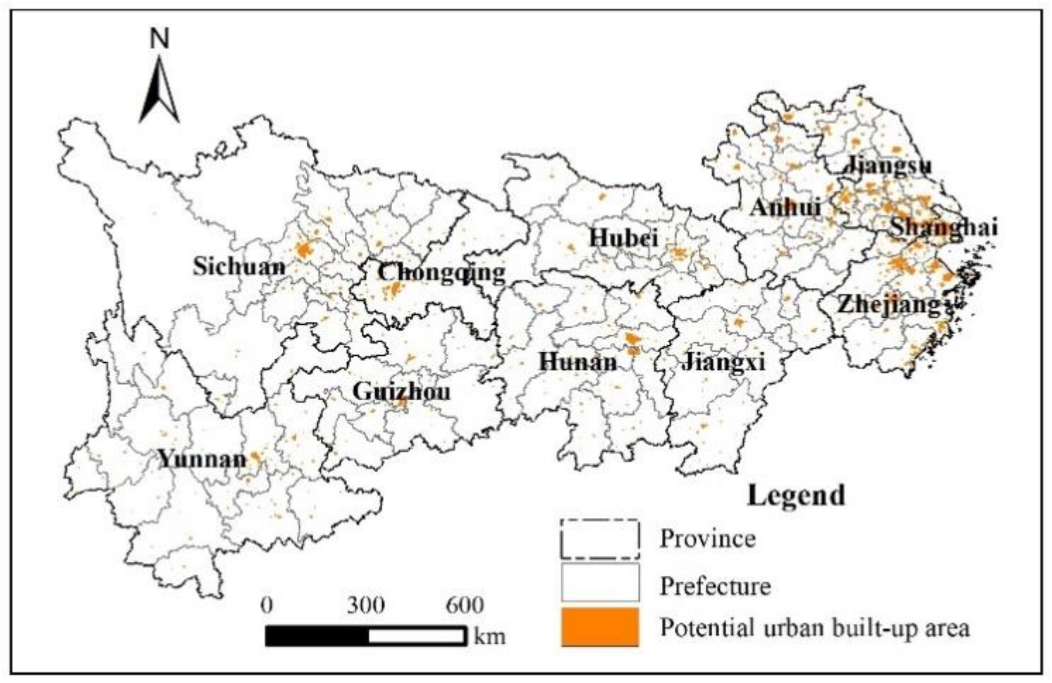
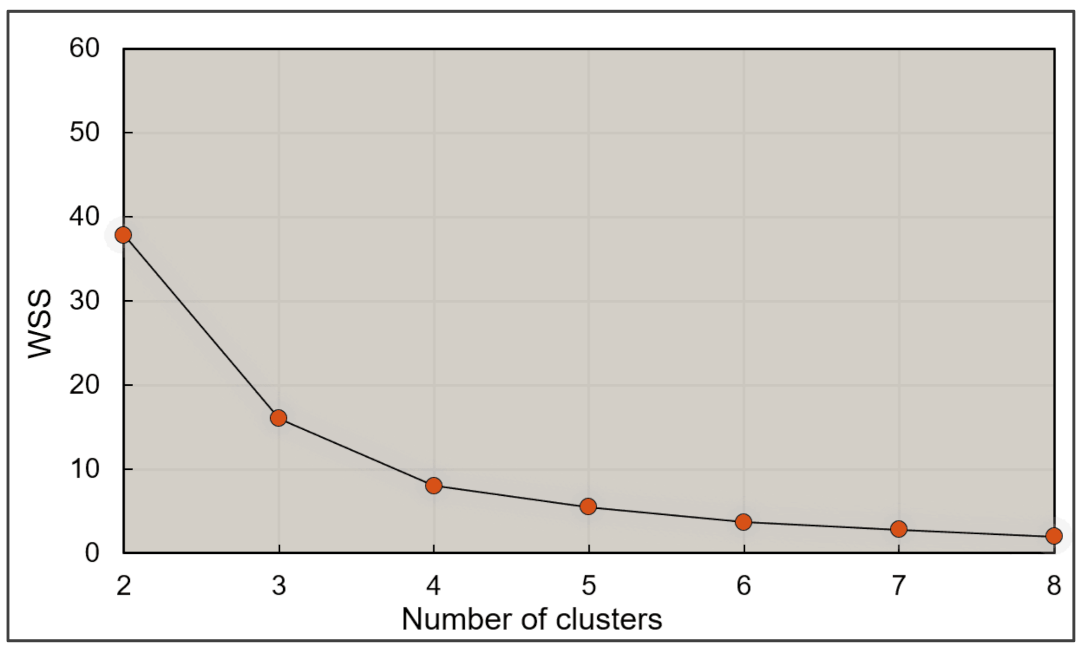
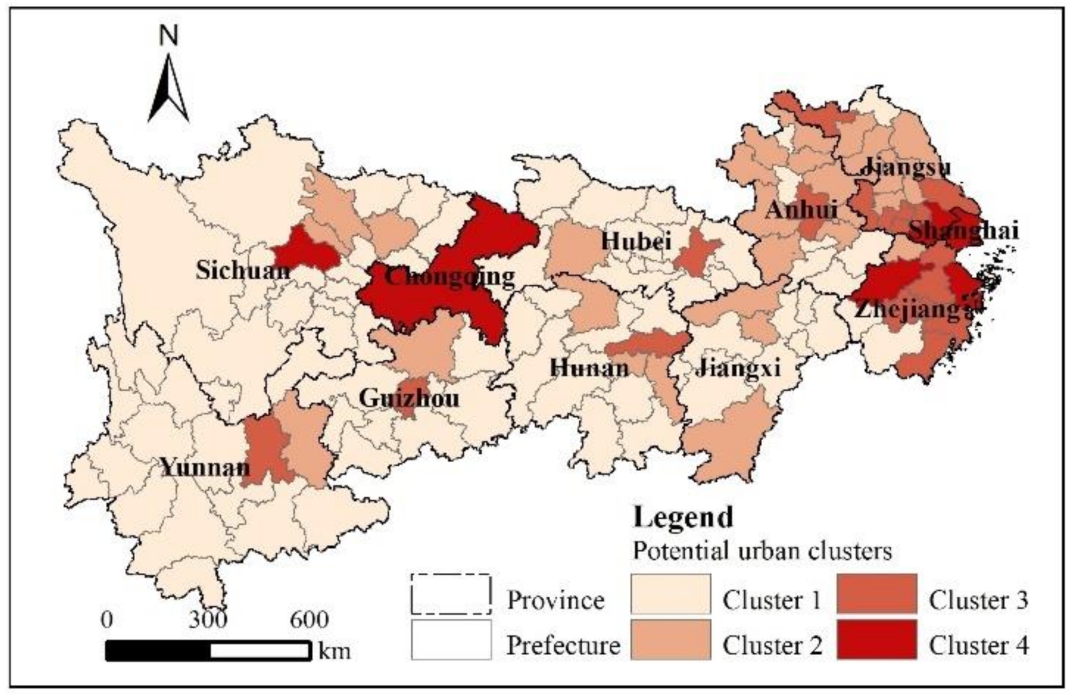
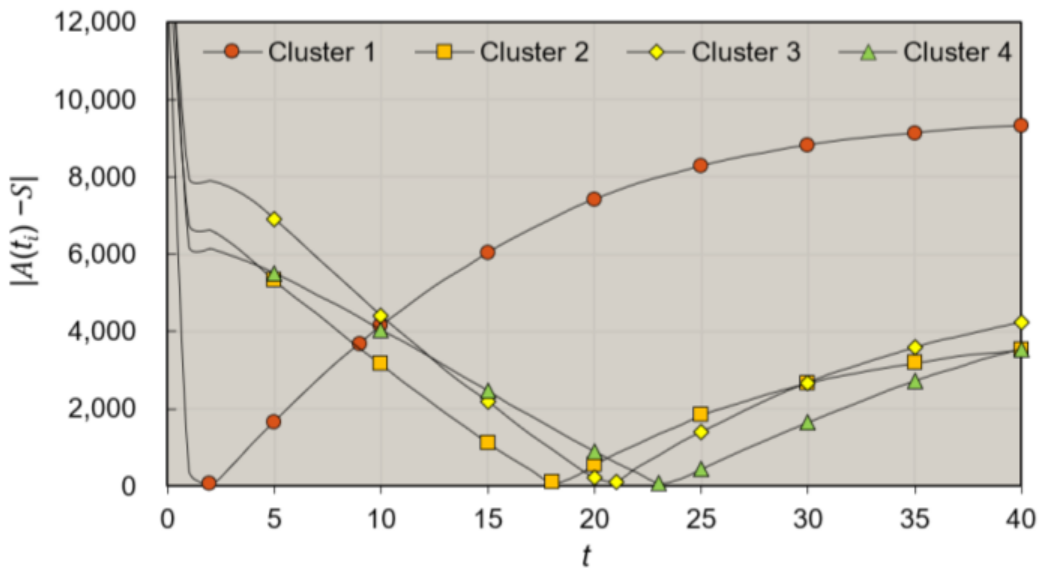
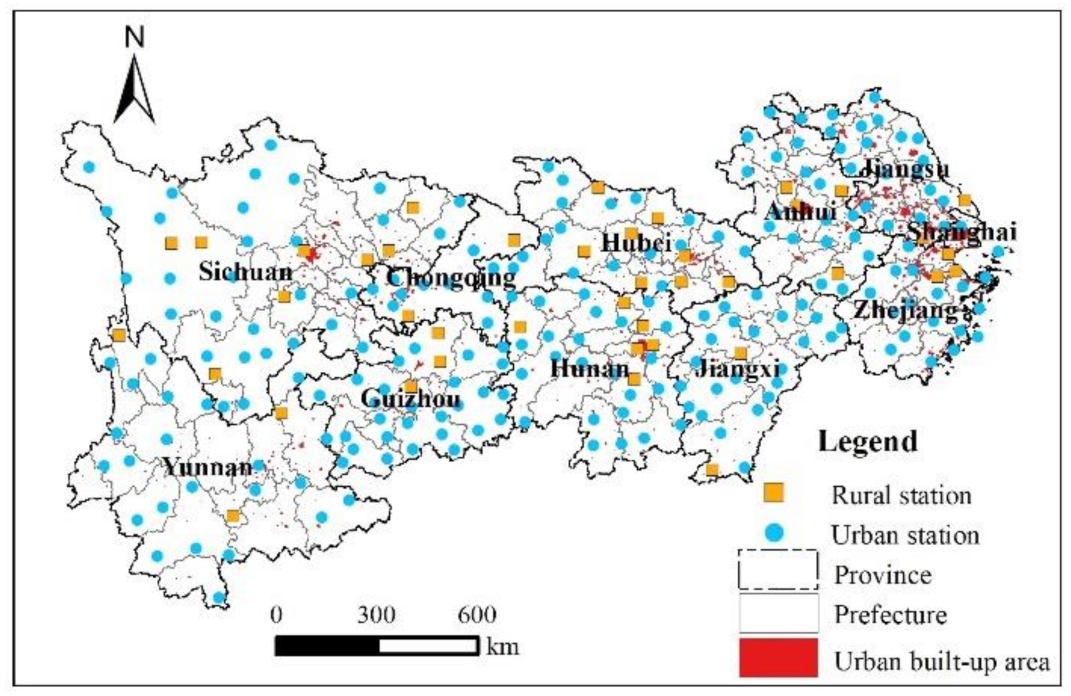
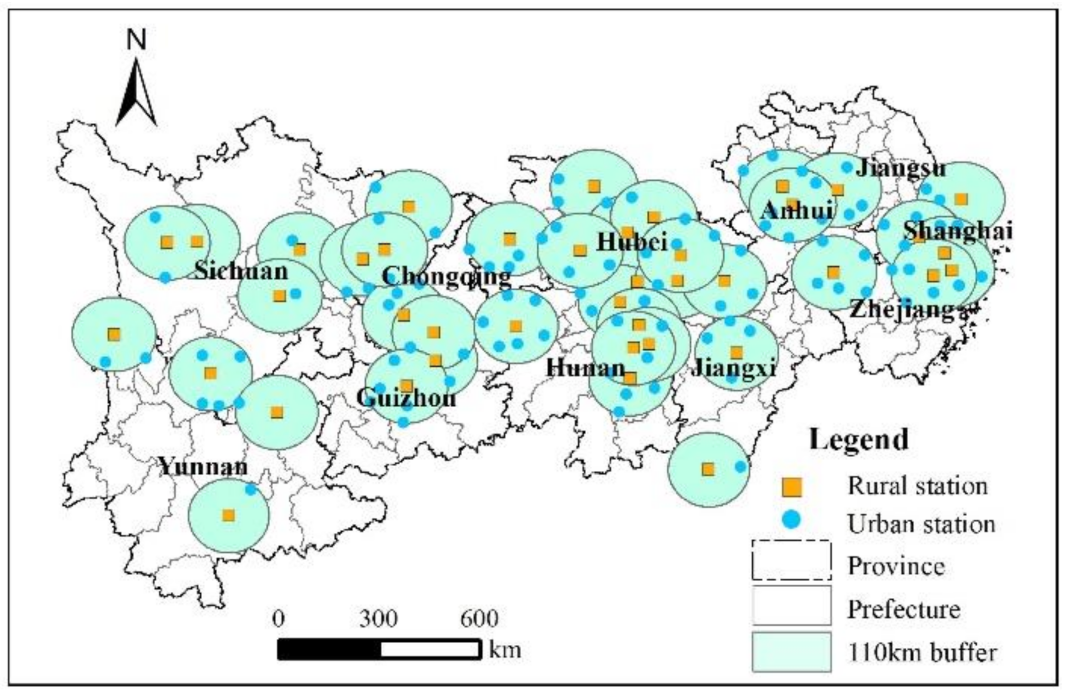

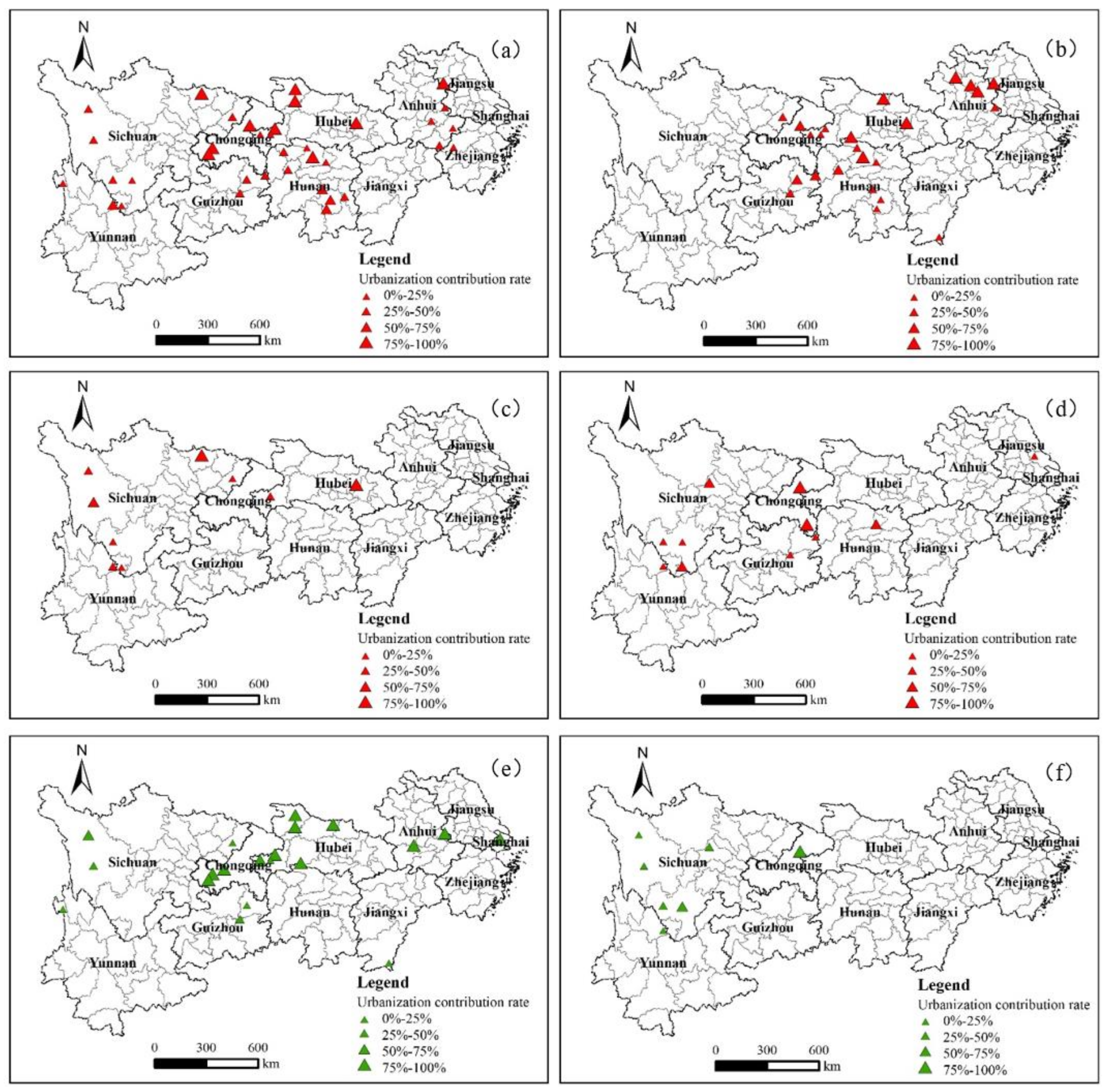


| Category | Index | Unit | Definition |
|---|---|---|---|
| Extreme temperature indices | FD0 * | day | Number of days with daily minimum temperature (TN) < 0℃ |
| ID0 * | day | Number of days with daily maximum temperature (TX) < 0℃ | |
| TN10P *, TN90P # | day | Number of days with TN < 10th (>90th) percentile | |
| TX10P *, TX90P # | day | Number of days with TX < 10th (>90th) percentile | |
| TR20 #, SU25 # | day | Number of days with TN > 20 ℃ (TX > 25 ℃) | |
| TNn, TNx/TXn, TXx | ℃ | Minimum (maximum) value of TN/TX | |
| DTR | K | Difference between TX and TN | |
| CSDI, WSDI | day | Number of days with TN < 10th (>90th) percentile for at least 6 consecutive days | |
| GSL | day | Numbers of days with daily average temperature>5℃ | |
| Extreme precipitation indices | SDII | mm/day | Annual precipitation divided by the number of wet days |
| CDD | day | Maximum number of consecutive days with daily precipitation amount (RR) < 1 mm (Maximum length of dry spell) | |
| CWD | day | Maximum number of consecutive days with RR ≥1 mm | |
| RX1day | mm | Maximum daily precipitation amount | |
| RX5day | mm | Maximum precipitation amount for 5 consecutive days | |
| R10mm, R20mm, R25mm | day | Number of days with RR > 10mm (20, 25 mm) | |
| R95P, R99P | day | Number of days with RR > 95th (99th) percentile | |
| Prcptot | mm | Annual precipitation amount |
Publisher’s Note: MDPI stays neutral with regard to jurisdictional claims in published maps and institutional affiliations. |
© 2022 by the authors. Licensee MDPI, Basel, Switzerland. This article is an open access article distributed under the terms and conditions of the Creative Commons Attribution (CC BY) license (https://creativecommons.org/licenses/by/4.0/).
Share and Cite
Yang, W.; Yan, Y.; Lin, Z.; Zhao, Y.; Li, C.; Zhang, X.; Shan, L. The Impact of Urbanization on Extreme Climate Indices in the Yangtze River Economic Belt, China. Land 2022, 11, 1379. https://doi.org/10.3390/land11091379
Yang W, Yan Y, Lin Z, Zhao Y, Li C, Zhang X, Shan L. The Impact of Urbanization on Extreme Climate Indices in the Yangtze River Economic Belt, China. Land. 2022; 11(9):1379. https://doi.org/10.3390/land11091379
Chicago/Turabian StyleYang, Wentao, Yining Yan, Zhibin Lin, Yijiang Zhao, Chaokui Li, Xinchang Zhang, and Liang Shan. 2022. "The Impact of Urbanization on Extreme Climate Indices in the Yangtze River Economic Belt, China" Land 11, no. 9: 1379. https://doi.org/10.3390/land11091379






